Exam Details
Exam Code
:1Z0-808Exam Name
:Java SE 8 Programmer ICertification
:Oracle CertificationsVendor
:OracleTotal Questions
:385 Q&AsLast Updated
:Jul 05, 2025
Oracle Oracle Certifications 1Z0-808 Questions & Answers
-
Question 261:
Given the code fragment:
// insert code here
arr[0] = new int[3];
arr[0][0] = 1;
arr[0][1] = 2;
arr[0][2] = 3;
arr[1] = new int[4];
arr[1][0] = 10;
arr[1][1] = 20;
arr[1][2] = 30;
arr[1][3] = 40;
Which two statements, when inserted independently at line // insert code here, enable the code to compile?
A. int [] [] arr = null;
B. int [] [] arr = new int [2];
C. int [] [] arr = new int [2] [ ];
D. int [] [] arr = new int [] [4];
E. int [] [] arr = new int [2] [0];
F. int [] [] arr = new int [0] [4];
-
Question 262:
Given: What is result?
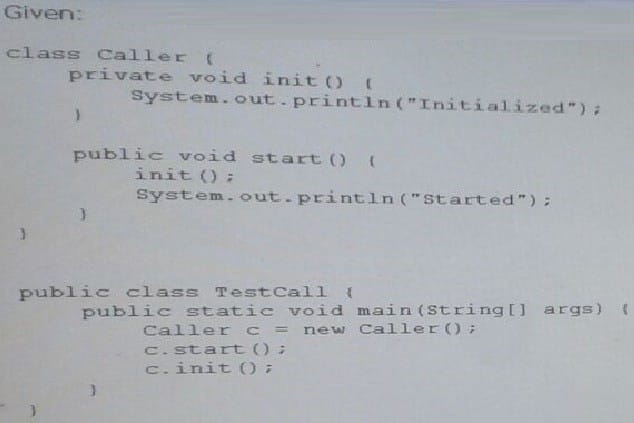
A. Successful
B. Unsuccessful
C. Compilation fails
D. An exception is thrown at runtime
-
Question 263:
Which two statements are true for a two-dimensional array?
A. It is implemented as an array of the specified element type.
B. Using a row by column convention, each row of a two-dimensional array must be of the same size.
C. At declaration time, the number of elements of the array in each dimension must be specified.
D. All methods of the class Object may be invoked on the two-dimensional array.
-
Question 264:
Given: What is the result?
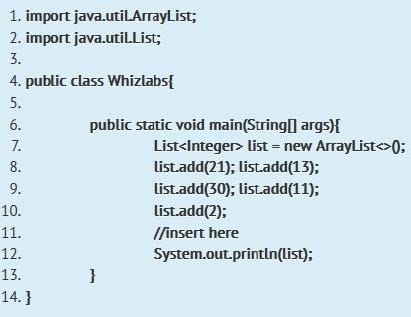
A. Initialized Started
B. Initialized Started Initialized
C. Compilation fails
D. An exception is thrown at runtime
-
Question 265:
Given: Which inserted at line 11, will provide the following output?

[21, 15, 11]
A. list.removelf(e > e%2 != 0);
B. list.removelf(e -> e%2 != 0);
C. Ust.removelf(e -> e%2 = 0);
D. list.remove(e -> e%2 = 0);
E. None of the above.
-
Question 266:
Given:

Which code fragment, when inserted at line 9, enables the code to print true?
A. String str2 = str1;
B. String str2 = new string (str1);
C. String str2 = sb1.toString();
D. String str2 = "Duke";
-
Question 267:
Given the code fragment:
int[] array = {I, 2, 3, 4, 5};
And given the requirements:
Process all the elements of the array in the order of entry. Process all the elements of the array in the
reverse order of entry. Process alternating elements of the array in the order of entry.
Which two statements are true?
A. Requirements 1, 2, and 3 can be implemented by using the enhanced for loop.
B. Requirements 1, 2, and 3 can be implemented by using the standard for loop.
C. Requirements 2 and 3 CANNOT be implemented by using the standard for loop.
D. Requirement 1 can be implemented by using the enhanced for loop.
E. Requirement 3 CANNOT be implemented by using either the enhanced for loop or the standard for loop.
-
Question 268:
Given the code from the Greeting.Java file:
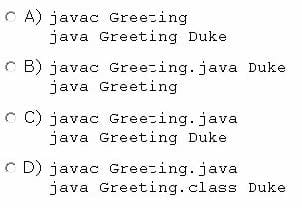
Which set of commands prints Hello Duke in the console?
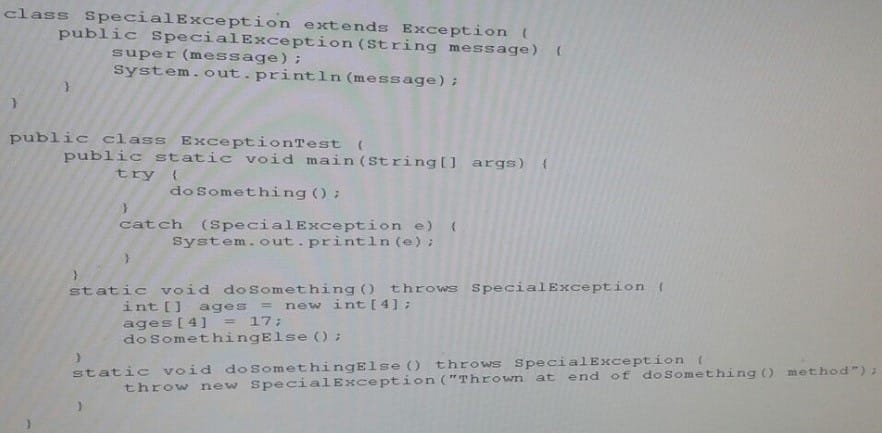
A. Option A
B. Option B
C. Option C
D. Option D
-
Question 269:
Given the following code:

What are the values of each element in intArr after this code has executed?
A. 15, 60, 45, 90, 75
B. 15, 90, 45, 90, 75
C. 15, 30, 75, 60, 90 D. 15, 30, 90, 60, 90
E. 15, 4, 45, 60, 90
-
Question 270:
Given the code fragment:
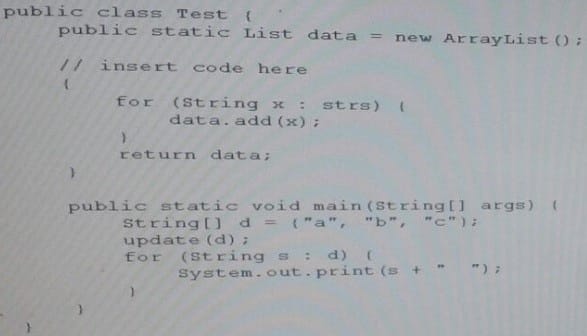
Which code fragment, when inserted at // insert code here, enables the code to compile and and print a b c?
A. List update (String[] strs)
B. Static ArrayListupdate(String [] strs)
C. Static List update (String [] strs)
D. Static void update (String[] strs)
E. ArrayList static update(String [] strs)
Related Exams:
1Z0-020
Oracle8i: New Features for Administrators1Z0-023
Architecture and Administration1Z0-024
Performance Tuning1Z0-025
Backup and Recovery1Z0-026
Network Administration1Z0-034
Upgrade Oracle9i/10g OCA to Oracle Database OCP1Z0-036
Managing Oracle9i on Linux1Z0-041
Oracle Database 10g: DBA Assessment1Z0-052
Oracle Database 11g: Administration Workshop I1Z0-053
Oracle Database 11g: Administration II
Tips on How to Prepare for the Exams
Nowadays, the certification exams become more and more important and required by more and more enterprises when applying for a job. But how to prepare for the exam effectively? How to prepare for the exam in a short time with less efforts? How to get a ideal result and how to find the most reliable resources? Here on Vcedump.com, you will find all the answers. Vcedump.com provide not only Oracle exam questions, answers and explanations but also complete assistance on your exam preparation and certification application. If you are confused on your 1Z0-808 exam preparations and Oracle certification application, do not hesitate to visit our Vcedump.com to find your solutions here.